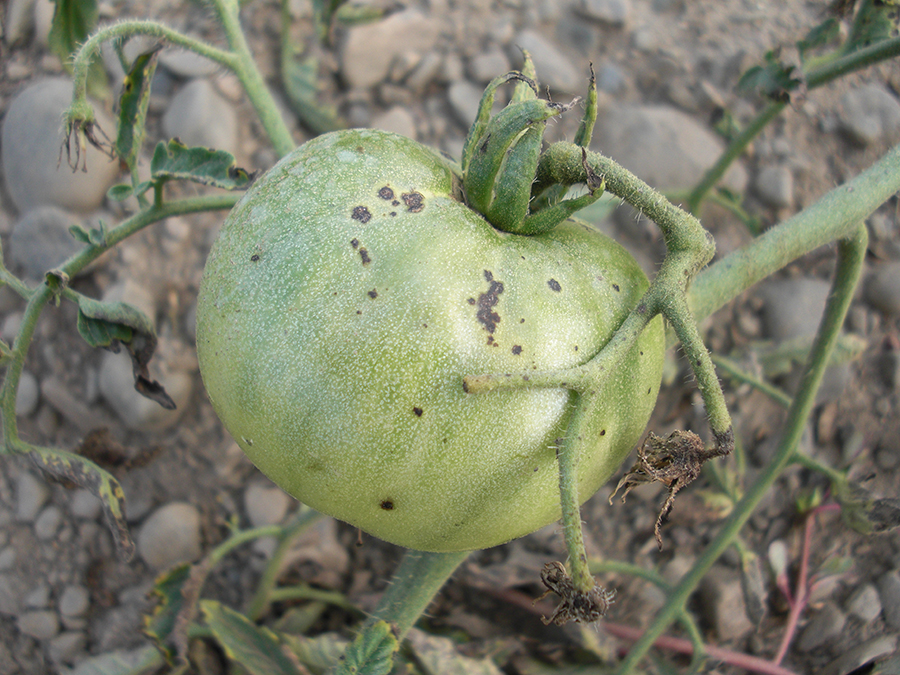Tomato researchers on hunt for speck-resistant varieties
By Patricia Waldron

The 2015 growing season was a tough one for tomato researchers at the Boyce Thompson Institute (BTI), due to the bacterial speck disease that descended on their field. But those infected plants may one day save others from a similar, spotted fate.
Cool weather and heavy rains in early summer created the perfect environment for speck – a disease that causes withered flowers and dark spots on leaves and fruits. The outbreak turned BTI’s tomato field in Freeville, New York, into a withered, mottled mess.
When researchers saw spots, farm manager Steve McKay called in Chris Smart, a plant pathologist at Cornell University’s Geneva campus, and BTI Professor Greg Martin to diagnose the problem. Martin studies tomato’s interactions with the bacterium that causes speck, Pseudomonas syringae pv. tomato, and field outbreaks provide a natural experiment to study those interactions.
“Although it creates serious problems for growers, the outbreak gives us the opportunity to observe if any established or experimental varieties have resistance to the local strains of the bacteria,” said Martin.
Since 2009, speck has been problematic for commercial producers in upstate New York who grow heirloom and fresh market tomatoes – the kind on grocery store shelves. Most of the tomatoes that end up in ketchup and tomato sauce, called processing tomatoes, carry a gene that makes them resistant to the bacteria.
“This year speck really has been devastating to a lot of growers throughout the state of New York and to some researchers too,” said Smart.
Once farmers identify the problem, it may be too late to control it. In a bad year, growers can lose whole fields.
“There are very few control products for bacterial diseases of vegetables,” said Smart. “If the symptoms are present in the field, the only thing they can do is to spray copper-based bactericides.”
To prevent speck, growers should buy certified clean seed and thoroughly clean all equipment with a sterilizing solution. Smart also recommends rotating crops so that tomatoes – or related crops like peppers, eggplant and potatoes – grow in a field once every three years.
A farmer’s best chance against speck is to use tomatoes that are naturally resistant. Processing tomatoes are immune to strains of Pseudomonas syringae pv. tomato designated as race 0, but there are no cultivated varieties that are resistant to race 1 types.
“I have gotten more interested in race 1 strains because they’re emerging as more and more of a problem,” said Martin.
In a new paper published in The Plant Genome, Martin reports finding a segment of DNA from a wild relative of the cultivated tomato, which imparts resistance to race 1 bacteria. To find this stretch of chromosome, dubbed qRph1, researchers in his lab screened seeds from the Tomato Genetics Resource Center at the University of California, Davis. One sample of a fuzzy, green-fruited species, called Solanum habrochaites, collected from Ecuador, showed resistance. They hybridized it to a cultivated tomato and then did the genetic work to map the location of the gene.
In future work, they will continue their breeding experiments to generate a variety of the cultivated tomato that carries the qRph1 resistance gene. The work highlights the importance of using wild relatives of cultivated crops as a source of valuable traits that have been lost through domestication.
Martin and Smart plan to use the speck-infested Freeville field next year to test different plants’ resistance to the natural speck strains there. With any luck, they’ll find resistance genes that may spare future New York farmers from plowing under a speckled crop.
Patricia Waldron is the staff science writer for the Boyce Thompson Institute.
Media Contact
Get Cornell news delivered right to your inbox.
Subscribe